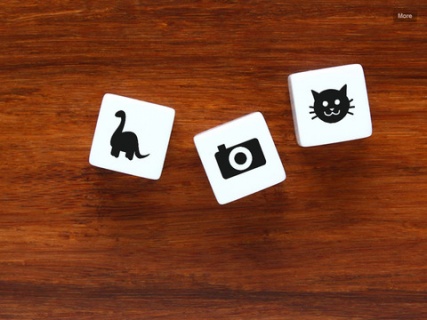Story Dice
Description
Story Dice is a creative writing prompt tool to come up with ideas for plot, character, and setting. It can be used for both written and oral storytelling.
“What we like to do, is take turns, each of us telling a story that uses all of those elements. And then we, as a family, vote on the best one.” – Mark Frauenfelder, editor of Make Magazine, appearing on NPR Morning Edition
This app can be used with a wide variety of age groups ranging from preschoolers to middle school and high school language arts students. The user interface is simple enough for ages 3+ to use without any additional instruction. The use of the app does not require reading, so it is an ideal tool for using in a preschool story circle (see lesson plans) as well as a general writing prompt for all ages without reading or native language barriers.
Features:
- Universal App!
- High-resolution graphics supporting Retina Display
- Choose number of dice to roll, 1-10.
- Realistic dice sounds and still images.
- 200+ pictograms in dictionary.
- Swipe to view previous rolls.
- No reading necessary.
- Optional game instructions included in app.
Game Ideas:
- Charades – Use the single die roll to determine a charade item.
- Stories With Friends – Form a circle. Roll the Story Dice (any number, 1-10). Create a sentence including all of the items from the dice. Pass to the next person and repeat, adding onto the story each time.
- Song Challenge – Roll a single story die. Come up with a song that includes that item in the lyrics.
- Poems With Friends – Same Stories With Friends, using only 1-2 dice, and create rhyming lines.
- Drama Club – Roll dice (any number). Form a character using these items, then create an improv skit with friends as your characters!
“Pictograms do not require the ability to read, which is great for my Kindergarteners and those who have difficulty reading.” – Consonantly Speaking, SLP blog
Education Applications:
Story Dice is primarily useful in higher order activities under Bloom’s Taxonomy, particularly Synthesis, where you create, invent, compose, predict, plan, construct, design, imagine, propose, devise, and/or formulate. You can devise less and more challenging activities, as in the following example.
Sample Journal Activity “My Perfect Day” using Bloom’s Taxonomy
Student/Short Version: Student will create a character using Story Dice, then describe/write/dramatize their own “perfect day” from their character’s perspective.
Teacher Version: Student will create a unique character using the Story Dice for seed ideas. After writing a short character sketch, student will compose a Journal Entry called “My Perfect Day” writing from their new character’s perspective. The evaluation step is the highest order activity and is a self-grading option.. Finally, a fun bonus option in a classroom or small workgroup setting is to have students perform their journal entries as monologues, in character, possibly interacting with each other, adding a drama element.
- Knowledge: Roll five or more Story Dice. Identify and describe the pictures on dice.
- Comprehension: Paraphrase the task (Journal Activity “My Perfect Day”) in which you will use the dice.
- Application: Prepare a chart with five categories: name, age, job, pets, hobbies. Place each dice image within a category. Imagine that you are this character and write a short paragraph describing yourself in detail.
- Analysis: Examine each feature of your character and determine what makes them special.
- Synthesis: Compose a journal entry called “My Perfect Day” from the character’s perspective.
- Evaluation: Decide what worked and what didn’t in your journal entry. Were you successful at combining the dice pictures in a believable way?
BONUS Activities: Perform journal entry as a monologue and interact with other students. Stay in character!
Pricing
| Plan | Price | Details |
|---|---|---|
| Story Dice | $1.99 | Paid mobile app. |
Reviews
A great iOS app for using dice to create story starters.






I project from my iPad to the Smartboard, bring up the dice, select it to show 3 dice, and tap a few times. Using the three dice that show up, students must write a poem (using a newly taught technique) of at least 10 lines that some how includes ideas related to the three dice.
It’s easy, and the students take to it well.